Biography
As a small boy, he lived with his parents, Franz Schedel and Josepha Thalherr, in Buda. He was sent to school in Cegléd. He studied medicine and practised as a doctor in Pest, but his interest in literature absorbed his attention, and he published a handbook on Hungarian poetry in 1828. He travelled to Berlin, London, and Paris, returning in 1830. From 1833 to 1844 he was a professor of dietetics at Pest University, and in 1836 helped found the Kisfaludy Society. He changed his name to Toldy in 1846. He had used it as a pseudonym from the beginning of his career.
He had already joined the Hungarian Academy, becoming its Secretary in 1835. He remained in this role until 1861 when he was appointed Professor of Hungarian Literature. His lastingly influential works were published in the 1850s and 1860s.
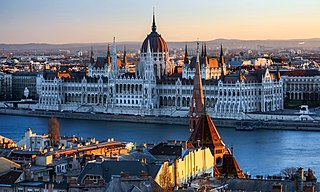
Budapest is the capital and most populous city of Hungary. It is the ninth-largest city in the European Union by population within city limits and it was the largest city on the Danube river; today it is the second largest one. The city has an estimated population of 1,752,286 over a land area of about 525 square kilometres. Budapest, which is both a city and municipality, forms the centre of the Budapest metropolitan area, which has an area of 7,626 square kilometres and a population of 3,303,786. It is a primate city, constituting 33% of the population of Hungary.

Ferenc Kazinczy was a Hungarian author, poet, translator, neologist, an agent in the regeneration of the Hungarian language and literature at the turn of the 19th century. Today his name is connected with the extensive Language Reform of the 19th century, when thousands of words were coined or revived, enabling the Hungarian language to keep up with scientific progress and become an official language of the nation in 1844. For his linguistic and literary works he is regarded as one of the cultural founders of the Hungarian Reform Era along with Dávid Baróti Szabó, Ferenc Verseghy, György Bessenyei, Mátyás Rát and János Kis.

Count Lajos Batthyány de Németújvár was the first Prime Minister of Hungary. He was born in Pozsony on 10 February 1807, and was executed by firing squad in Pest on 6 October 1849, the same day as the 13 Martyrs of Arad.
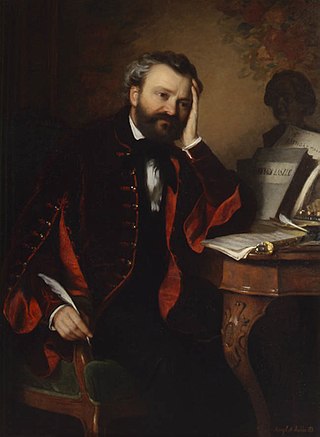
Ferenc Erkel was a Hungarian composer, conductor and pianist. He was the father of Hungarian grand opera, written mainly on historical themes, which are still often performed in Hungary. He also composed the music of "Himnusz", the national anthem of Hungary, which was adopted in 1844. He died in Budapest.

Cegléd is a city in Pest county, Hungary, approximately 70 km (43 mi) southeast of the Hungarian capital, Budapest.
The "Rákóczi March", sometimes known as the "Hungarian March" was one of the unofficial state anthems of Hungary before Ferenc Kölcsey wrote the Himnusz. It was most likely composed by Nikolaus Scholl in 1820. The melody later used in many famous compositions, most notably: La damnation de Faust and Hungarian Rhapsody No. 15.

Albert Franz Doppler, was a flute virtuoso and a composer best known for his flute music. He also wrote one German and several Hungarian operas for Budapest, all produced with great success. His ballet music was popular during his lifetime.

The Halászbástya or Fisherman's Bastion is one of the best known monuments in Budapest, located near the Buda Castle, in the 1st district of Budapest. It is one of the most important tourist attractions due to the unique panorama of Budapest from the Neo-Romanesque lookout terraces. The Fishermen's Bastion's main façade, parallel to the Danube, is approximately 140 meters long, of which the southern aisle is about 40 meters long, the north is 65 meters long, and the ornate central parapet is 35 meters long. Its seven high-pitched stone towers symbolize the seven chieftains of the Hungarians who founded Hungary in 895.
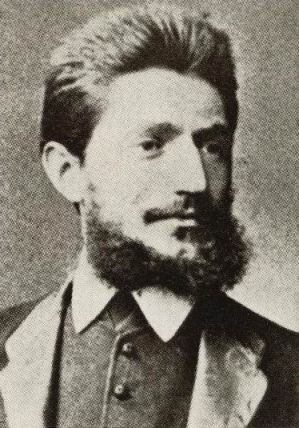
Gyula Pártos was a Hungarian architect. Together with Ödön Lechner he designed a number of buildings in the typical Szecesszió style of fin-de-siècle Hungary. He was the brother-in-law of the lawyer and politician Béla Pártos, the husband of opera singer Vittorina Bartolucci, and the father-in-law of composer and opera director Miklós Radnai.

Alajos Hauszmann was a Hungarian architect, professor, and member of the Hungarian Academy of Sciences.

The Hungarian Revolution of 1848, also known in Hungary as Hungarian Revolution and War of Independence of 1848–1849 was one of many European Revolutions of 1848 and was closely linked to other revolutions of 1848 in the Habsburg areas. Although the revolution failed, it is one of the most significant events in Hungary's modern history, forming the cornerstone of modern Hungarian national identity—the anniversary of the Revolution's outbreak, 15 March, is one of Hungary's three national holidays.

The city of Budapest was officially created on 17 November 1873 from a merger of the three neighboring cities of Pest, Buda and Óbuda. Smaller towns on the outskirts of the original city were amalgamated into Greater Budapest in 1950. The origins of Budapest can be traced to Celts who occupied the plains of Hungary in the 4th century BC. The area was later conquered by the Roman Empire, which established the fortress and town of Aquincum on the site of today's Budapest around AD 100. The Romans were expelled in the 5th century by the Huns, who were challenged by various tribes during the next several centuries. The Hungarian conquest of the Carpathian Basin started at the end of the 9th century, and the Kingdom of Hungary was established at the end of the 11th century.
Aurora was a literary journal founded by Károly Kisfaludy in 1821. It was crucial in the development of Romanticism in Hungarian literature, and in establishing Pest as a literary centre. The magazine adopted a progressive literary approach.
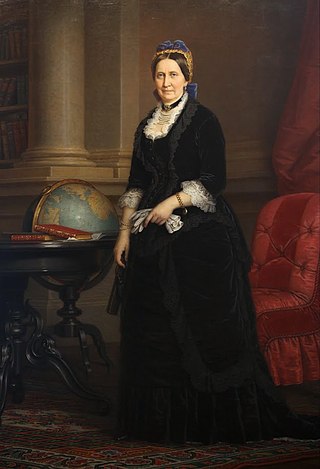
Hermína Karolína Benická Verešová commonly known as Pálné Veres was a teacher and feminist from the Slovak Region of the Kingdom of Hungary. Her family were German-speaking Lutherans. Her father was an official in Nógrád County, but after his death in 1816, the family moved to Buda. She was educated until the age of sixteen by her mother, a teacher who died in the cholera epidemic of 1831. Taken in by her grandfather, she embarked on a period of self-study from his library. After moving to Pest with the help of an aunt, Benická worked to improve her Hungarian and continued her studies. Upon her marriage, she adopted the name Pálné Veres.

Miksa Falk was a Hungarian politician, journalist, member of the Hungarian Academy of Sciences and the editor-in-chief of the German-language newspaper Pester Lloyd.
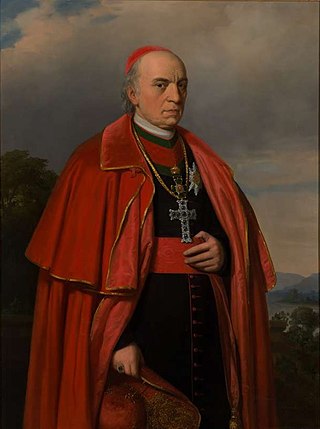
János Keresztély Scitovszky de Nagykér was a Hungarian prelate, Cardinal of the Roman Catholic Church and Archbishop of Esztergom and Primate of Hungary.

József Kiss was a Hungarian poet and editor.
Mihail George Boiagi was an Aromanian grammarian and professor in the Habsburg monarchy and the Austrian Empire. He was born on 3 February 1780 in Buda, today Budapest in Hungary. Boiagi was one of the first grammarians from the Balkans and a professor in a school in Vienna, where he taught Greek. He had origins from Moscopole, today in Albania. Boiagi was one of the main figures of the Aromanian diaspora in Austria and Hungary, the capitals of which, Vienna and Budapest respectively, became gathering centers for members of this community in the 19th century. Boiagi introduced the Aromanian historian Dimitrie Cozacovici to the Aromanian community of Austria and Hungary after Cozacovici's migration from Metsovo, today in Greece, to Buda.

The First Battle of Szolnok was a battle in the Hungarian war of Independence of 1848-1849, fought on 22 January 1849 between the revolutionary Hungarian army led by General Mór Perczel against the cavalry brigade of the Austrian Empire led by General Ferenc Ottinger. The isolated troops of Ottinger were attacked by Perczel's superior army and were forced to retreat from Szolnok to Abony, then to Cegléd. This Hungarian victory was a sign that the Austrian troops, which after the occupation of the Hungarian capitals of Pest and Buda, believed that they already won the war, were far away from reaching that goal, and that the Hungarian army could cause them unpleasant surprises. After the Battle Perczel's troops continued the pursuit of Ottinger's troops to Cegléd.

The Battle of Cegléd was a battle in the Hungarian war of Independence of 1848-1849, fought on 25 January 1849 between the revolutionary Hungarian army led by General Mór Perczel against the cavalry brigade of the Austrian Empire led by General Ferenc Ottinger. After the First Battle of Szolnok Ottinger retreated to Cegléd and received some infantry reinforcements to his cavalry brigade. Perczel decided to continue his attack, and when Ottinger felt that he was about to be encircled by the Hungarian troops, decided to retreat from the battlefield. Thus this battle was confined merely to an artillery duel, ending in an Austrian retreat. Perczel's victories at Szolnok and Cegléd, were the first important Hungarian successes in the Western theater against the main Austrian army after the start of their offensive against Hungary in mid-December 1848, panicking the Imperial-Royal army's commandment in Pest, forcing it to call back the bulk of their troops which were pursuing Artúr Görgei's Upper Danube Corps in Northern Hungary.

















